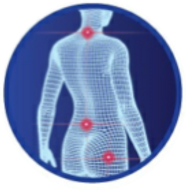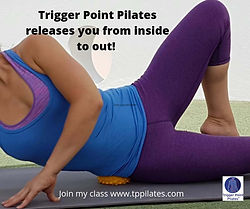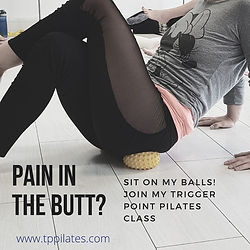Trigger Point Pilates

Trigger Point Pilates (TPP) is ideal for everyone however fit, and effective for pre and post surgery after your Physio check. Many of the exercises you can do at home to gain constant benefits of fascia release.
Wear comfortable clothing that is not too tight to move in and wear socks or Yoga shoes in class if you have a skin/foot condition. Please bring a small towel to use in class and water to drink.
The fascia release can stimulate the bladder, please do not feel embarrassed to go to the loo.
In class or after class you may experience some of the following:
-
Working on equipment you can feel discomfort/burning/cracking/popping/a tearing feeling. These are only temporary while the fascia is being released. As the fascia releases using your body weight you are slowly working deeper and deeper on certain areas of your body.
-
If you have any sharp, shooting, electric nerve pain, this is a sign that something is wrong. Please inform your instructor.
-
After class you may feel extremely relaxed, body lengthened and your joints released. A sense of feeling taller. You may notice a sudden burst of energy as your body is working more efficiently. Just do as you feel but don't go crazy as your body is adjusting.
-
You could feel that you just want to relax and sleep, listen to your body as this is healing time. You may notice mild discomfort from headaches, to sweating to the body getting hot. Again, this is a reaction to the fascia releasing.
-
You may notice a mood change. As feel good factor hormones have been released in your system but you can be a bit sensitive. If this is the case, make time for yourself to do some deep breathing.
-
You may notice a change in your appetite and start craving foods that your body is lacking nutritionally. Listen to your body, feed it foods that are going to assist with healing and cellular regeneration.
-
You can feel headachy or a deep ache due to the body re-structuring itself and toxins being released via your lymphatic/nervous system. This will pass, just keep well hydrated.
How often should you do a class?
It is a good idea to do two or three Trigger Point Pilates classes a week, if possible. And you can exercise daily at home with the right equipment. You can buy equipment from your instructor for home use. The class will actually prepare your body and warm you up to do more strenuous exercise such as dance, jogging or the gym.
History of Trigger Point Pilates
Trigger Point Pilates, has been created from years of clinical work and Pilates teaching experience by Lydia Campbell, a Fitness Industry expert for over 40 years. She created TPP for fascia health to cater for chronic painful conditions and scar tissue. This programme has just been released after 13 years of her own research from clinical work and TPP class teaching. Including her own personal rehab journey and living with osteoarthritis after years of intense exercise and professional dance.
A Trigger Point Pilates TM combines Pilates' core moves and applies clinical Myofascial principles to help alleviate chronic pain conditions. The class is designed to release tight muscles and enhance functional daily movement and restructure the body. This class attracts everyone from the elite fit, to the post rehab. Equipment is used to release and realign the body.
What is Myofascial Myo = Muscle and Fascia - means a continuous band of connective tissue wrapping around and throughout the body. The transparent film is fascia; our bodies are made of fascia. There is a massive science on using Myofascial release for chronic painful conditions and scar tissue through Myofascial work. Fascia is the system of connective tissue that lay just under the surface of the skin. Under a microscope, fascia is highly organised tissues filled with water, and its job is to attach, stabilise, enclose and separate muscles and internal organs.


Welcome to

